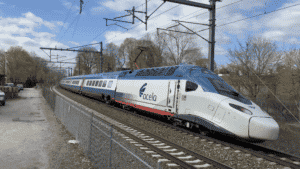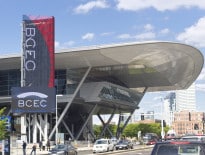
One of the newest Amtrak trains to ply the Northeast Corridor undergoes testing in Rhode Island in April 2021. Photo courtesy of Fan Railer | CCY BY-SA 4.0
While funding questions still loom, rail service improvements in the Boston area figure prominently in a new $117 billion plan assembled by officials in eight states along the Northeast Corridor that holds the promise of generating $1.7 million jobs over 15 years.
The 13-year-old Northeast Corridor Commission on Wednesday released its plan, dubbed CONNECT NEC 2035 (C35), calling it “the most ambitious reinvestment program” in the corridor’s history. The plan features 150 projects and was built cooperatively by state and federal government officials, and representatives from commuter rail agencies and Amtrak. Its supporters said it features a “detailed and efficient sequencing of infrastructure investments.”
Architects of the plan say it will require a “strong federal-state funding partnership,” estimating the funding gap associated with the plan at $100 billion. The plan arrives as members of Congress continue work on a major infrastructure financing bill, but remain divided over its critical details.
Jamey Tesler, who is nearing his fifth full month as Gov. Charlie Baker’s acting transportation secretary, said the plan’s goals are far-reaching: improved mobility, job creation, fighting climate change, opening up access to opportunities, and continuing to make the Northeast a “global economic powerhouse.”
Calling the plan’s long-term vision “the culmination of two years of hard work and detailed analysis,” Tesler said, “It also represents the start of a new level of coordination among Amtrak, NEC state and commuter railroads, and the federal government.”
The corridor runs from Washington D.C. up to Boston, its northern terminus, and currently supports more than 800,000 daily passenger trips.
The corridor’s New England territory, at 156 miles, is the longest of five territories and is marked by “lower capacity infrastructure” than the other four territories, according to the commission, with almost the entire territory limited to two tracks or, in the case of two Hartford Line locations, one.
While the other four territories have more operating flexibility and reliability due to long four-track sections, the New England territory has very few locations where faster trains can overtake slower trains without blocking all traffic traveling in the opposing direction, the commission said.
If embraced and funded, the plan could generate more than 110,000 direct and indirect jobs in New England over its 15-year life and its drafters say it will result in something that’s proven elusive to many rail riders: “a modern and resilient railroad with safe, reliable, and more frequent service; connections to new markets; and reduced travel times between communities.”
The plan outlines a series of benefits specific to the Greater Boston area and New England, including:
- Faster commuter rail trips due to infrastructure modifications and new express service patterns. The report says MBTA trains were delayed over 2,100 hours in fiscal year 2019 and that “significant upgrades” will be made at the Tower 1 Interlocking — the point where trains are distributed among the platforms at Boston’s South Station. The project is designed to increase maximum allowable speeds near the train hub to 15 mph, up from 10 mph;
- Chopping 28 minutes off the trip time on an Acela ride from New York City to Boston;
- The Massachusetts Third Track project that supports additional service by adding a third track between Readville and Canton Junction stations. Eliminating the two-track configuration in the area, according to the plan, will mitigate an existing bottleneck for Amtrak and MBTA services;
- The conversion of commuter rail service between Boston, Providence, and points west from diesel trains to high-performance electric trains, reducing commute times by up to 16 minutes;
- So-called “capital renewal programs” focused on track turnouts, signal bridges and culverts, electric power supply (transmission wire), communications and signals, including the replacement of 100 percent of interlockings and 40 under-grade bridges;
- “Early progress” toward meeting long-term performance objectives by reducing Boston to Washington travel time by nearly an hour;
- Improvements that will serve as a “foundation for future high-speed service and put in motion the development of new high-speed segments capable of delivering world-class service to the region.” Anticipated track upgrades would expand the track miles capable of supporting 160 mph Acela service;
- New MBTA service between Pawtucket/Central Falls, R.I. and Boston.
Congress created the commission 13 years ago to develop coordinated rail network strategies across the states with a stake in the corridor’s operations.
The Commission is governed by a board comprised of one member from Massachusetts, Rhode Island, Connecticut, New York, New Jersey, Pennsylvania, Delaware, Maryland and the District of Columbia; four members from Amtrak; and five members from the U.S. Department of Transportation.




 |
| 



